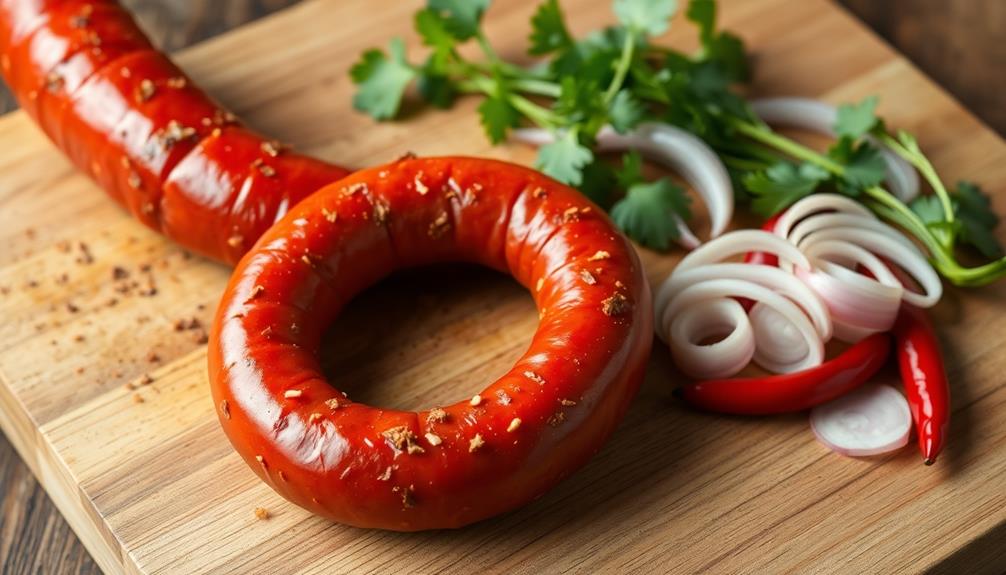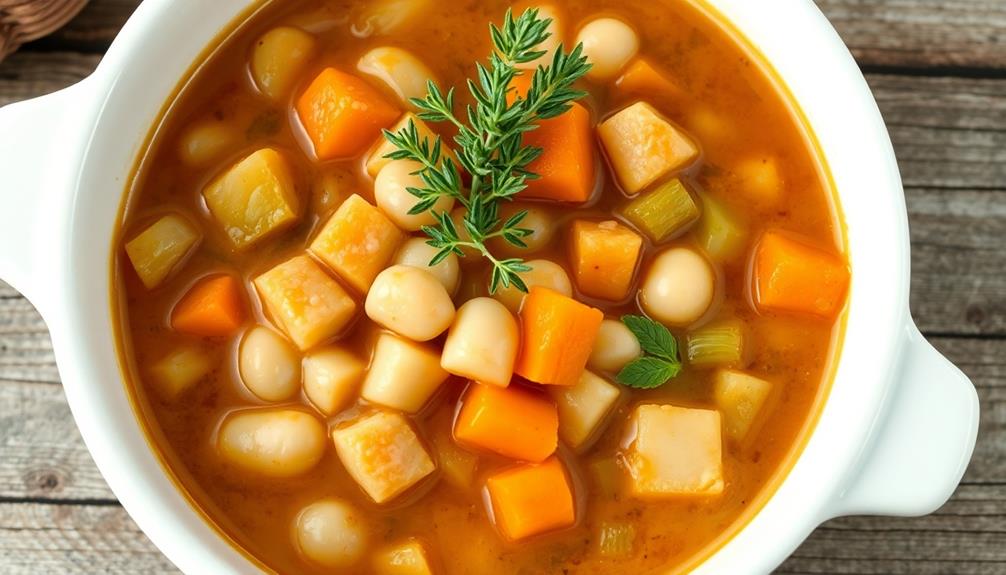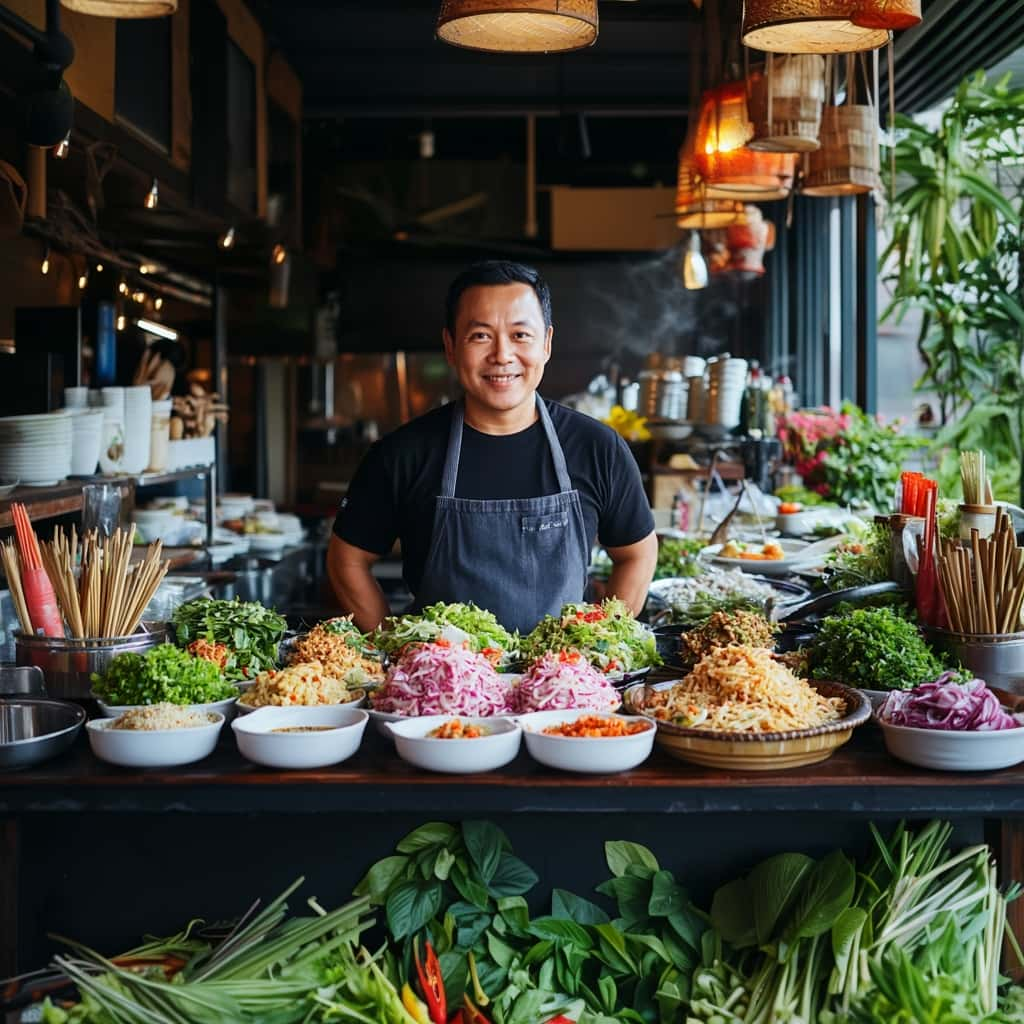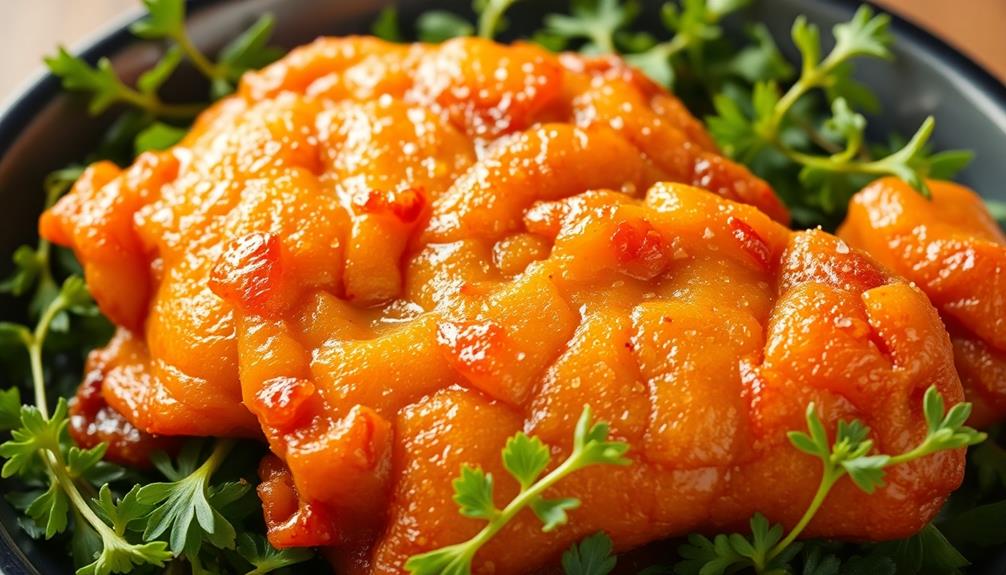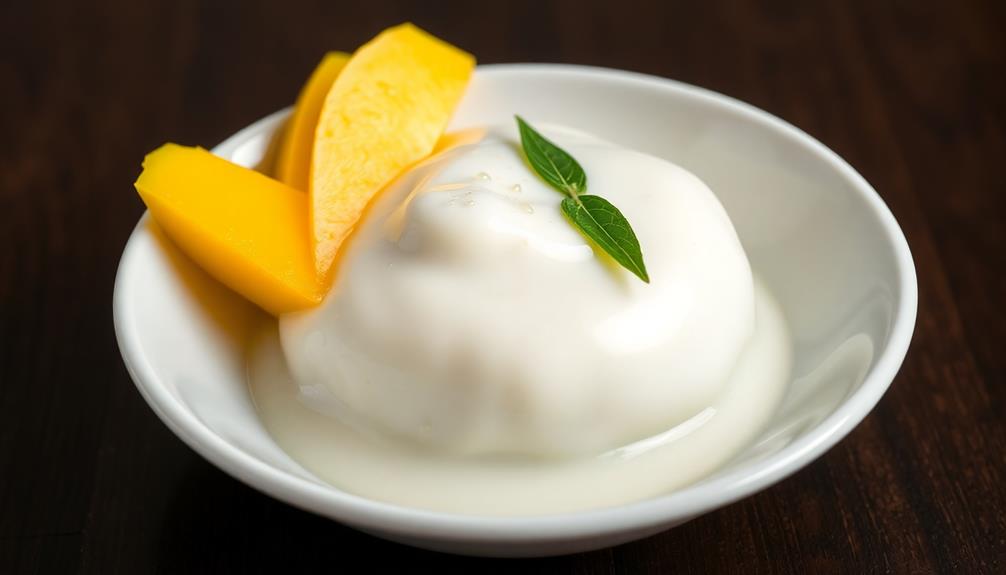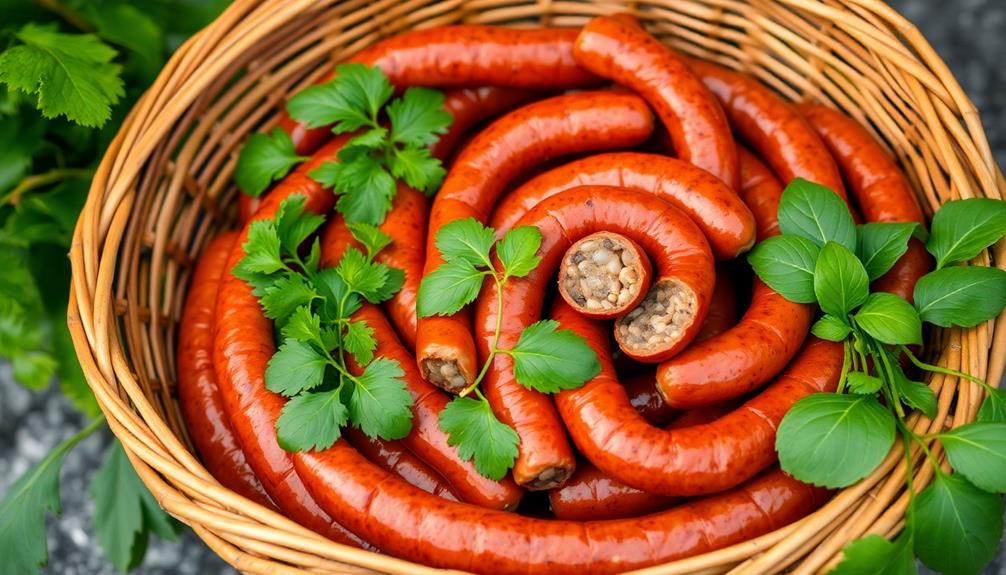Sai Oua, the centuries-old Northern Thai sausage, offers a unique blend of indigenous and regional flavors. You'll find this delicacy at celebrations and community events across the region, as it's a source of culinary pride. To make it, you'll mix ground pork with aromatic herbs like lemongrass, kaffir lime, and galangal, plus chili, fish sauce, and toasted sticky rice powder. You'll stuff the mixture into casings, tie it into links, and smoke the sausages over charcoal until fully cooked. Chilled and sliced, Sai Oua makes a delightful appetizer or snack. And there's more to discover about this beloved northern Thai specialty. In addition to Sai Oua, the Northern Thai sausage, the region is also known for its traditional Isaan sausage, which has a distinct flavor profile all its own. Made with a similar process, the Isaan sausage features a unique blend of local herbs and spices, giving it a one-of-a-kind taste that has been passed down through generations. Both sausages reflect the rich culinary heritage of the Northern Thai region and are a must-try for anyone visiting or exploring the area’s food culture.
Key Takeaways
- Sai Oua is a traditional Lao sausage originating from the ancient Lao kingdom of Lan Xang, reflecting local culinary traditions in Northern Thailand.
- The name "Sai Oua" translates to "sour sausage," indicating its fermented flavors.
- Sai Oua serves as a link to Northern Thai culinary heritage, often featured at celebrations, family gatherings, and community events.
- The recipe and preparation methods have evolved over centuries, influenced by regional cultures and local herbs, spices, and culinary practices.
- The intricate preparation process reflects the dedication of producers and preserves traditional cooking methods passed down through generations.
History
Sai Oua, a traditional Lao sausage, has a rich history that dates back centuries. Its origins can be traced to the ancient Lao kingdom of Lan Xang, where it was a beloved staple among the people.
The name "Sai Oua" translates to "sour sausage" in the Lao language, reflecting the fermented flavors that have characterized this unique delicacy for generations.
Over time, the recipe and preparation methods for Sai Oua have been passed down, evolving with the cultural influences of the region. The sausage is typically made from a blend of ground pork, rice, and a variety of aromatic herbs and spices, including lemongrass, kaffir lime leaves, and galangal.
The mixture is then stuffed into natural casings and left to ferment, allowing the flavors to develop and meld together.
Today, Sai Oua remains an integral part of Lao cuisine, enjoyed as a snack, appetizer, or even a main dish. Its distinctive sour, savory, and slightly spicy profile has made it a beloved staple among locals and travelers alike, showcasing the rich culinary traditions of northern Thailand.
Recipe
Sai Oua, a flavorful pork sausage dish that originated in the Isan region of Thailand, is a beloved staple in Thai cuisine. The unique blend of spices and herbs, combined with the juicy pork, creates a mouthwatering dish that's sure to delight the senses.
The preparation of Sai Oua is a labor of love, requiring careful attention to detail to achieve the perfect balance of flavors. This recipe will guide you through the process, allowing you to recreate this authentic Thai delicacy in your own kitchen.
- Pork shoulder, minced
- Lemongrass, finely chopped
- Kaffir lime leaves, finely chopped
- Galangal, grated
- Shallots, finely chopped
- Bird's eye chili, finely chopped
- Fish sauce
- Toasted sticky rice powder
- Salt
Begin by mixing the minced pork, lemongrass, kaffir lime leaves, galangal, shallots, and bird's eye chili in a large bowl. Add a few tablespoons of fish sauce and the toasted sticky rice powder, and mix thoroughly until well combined.
Season with salt to taste. Stuff the mixture into natural sausage casings, ensuring an even distribution. Twist or tie the sausages into desired lengths.
When cooking Sai Oua, it's important to maintain a gentle heat to prevent the sausages from bursting. Grill or pan-fry the sausages, turning occasionally, until they're cooked through and develop a nice char on the outside.
Serve hot, accompanied by sticky rice, fresh vegetables, and a dipping sauce of your choice.
Cooking Steps
Start by mixing the ground meat until it's well-combined.
Next, stuff the meat mixture into sausage casings and tie them into links.
Step 1. Mix Ground Meat
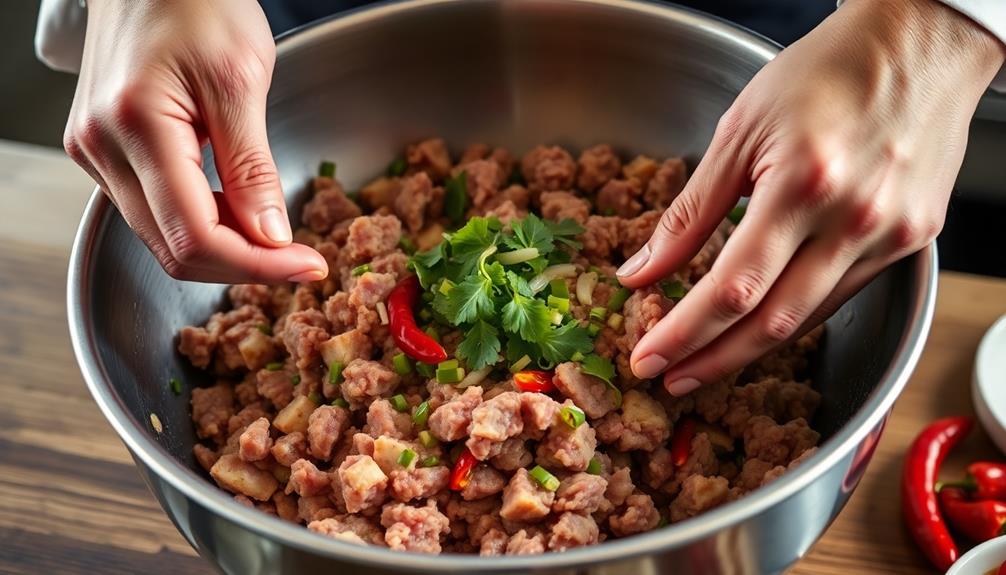
Next, you'll need to thoroughly mix the ground meat. Place the ground meat in a large mixing bowl.
Using your hands, gently work the meat, squeezing and folding it over itself to evenly incorporate all the ingredients. Be careful not to overwork the meat, as this can make it tough.
Once the seasonings and aromatics are evenly distributed, the meat should have a smooth, cohesive texture. Take your time with this step – thorough mixing is crucial for achieving the signature flavor and texture of authentic sai oua sausage.
After mixing, you can begin shaping the sausages. Pinch off a small amount of the seasoned meat, roll it between your palms to form an oblong shape, and then gently squeeze it to remove any air pockets.
Repeat this process until you've shaped all the meat.
Step 2. Stuff Mixture Into Casings
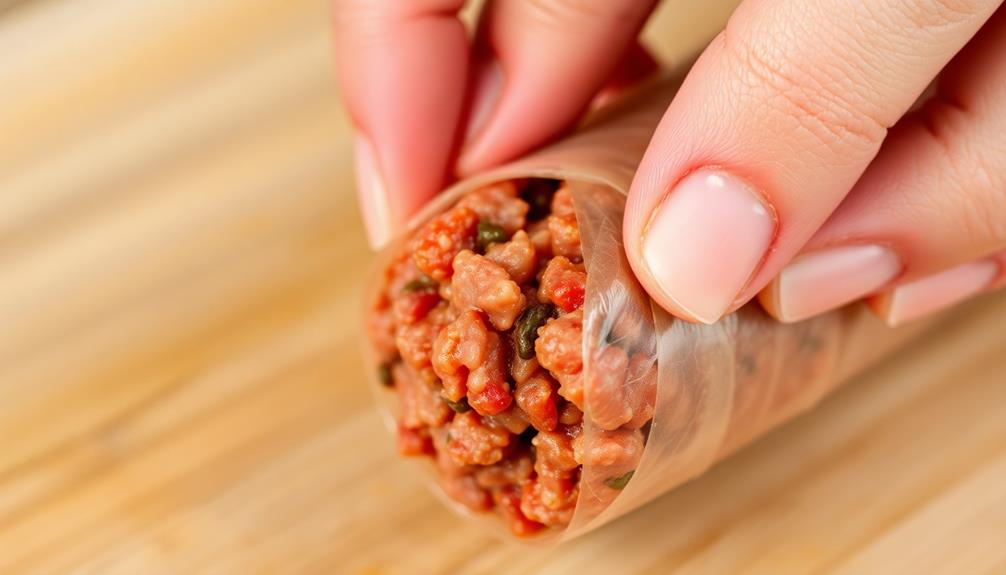
With the ground meat thoroughly mixed, it's time to fill the sausage casings.
Grab a length of natural or synthetic casing and slide it onto the end of your sausage stuffer. Gently pack the spiced meat mixture into the hopper, being careful not to overstuff.
As you turn the handle, the meat will be pushed through the stuffer and into the casing, creating an even, sausage-like shape. Don't be afraid to adjust the pressure and flow to ensure a consistent fill.
Once the casing is full, use your fingers to gently twist it into individual links, pinching and twisting at the desired intervals.
Be mindful not to pack the links too tightly, as you want to leave room for the sausage to expand during cooking.
With your freshly stuffed sausages ready, it's time to move on to the next step – poaching or smoking to finish the Sai Oua.
Step 3. Tie Sausages Into Links
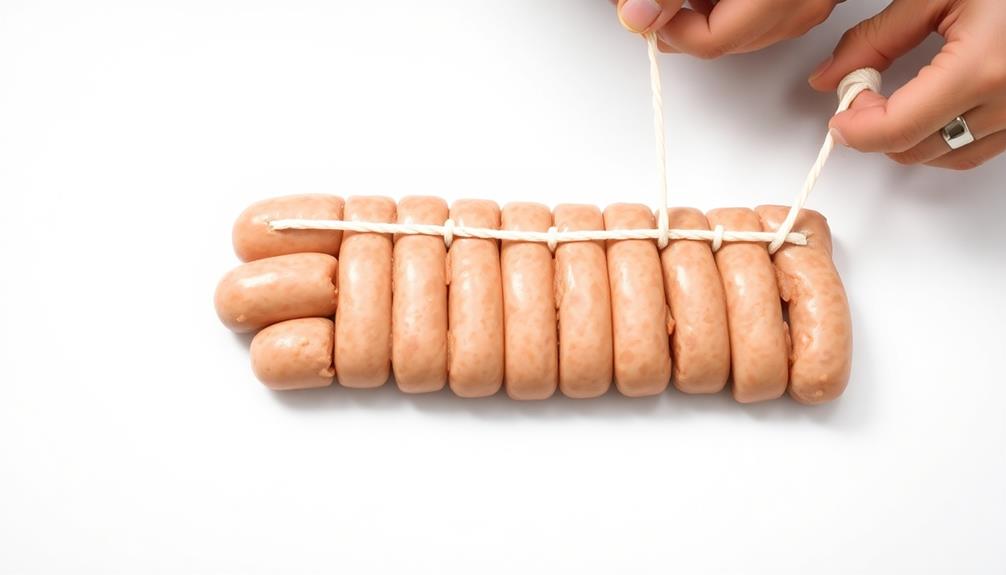
Once the sausage casings are filled, take the time to carefully twist and tie them into individual links.
Gently twist the casing into 4-5 inch segments, pinching the end of each link to seal it. Tie off the links using kitchen string, leaving a couple inches of space between each one.
This step is crucial for achieving the classic sausage shape and ensuring the meat stays contained as it cooks. Work slowly and deliberately, taking care not to overstuff the casings or create weak points that could tear.
With a bit of practice, you'll get the hang of this technique. Once all the links are tied, the sausages are ready for their final cooking stage.
Hang or place them in the fridge until you're ready to simmer, grill, or pan-fry them to perfection. The care you take in this process will result in beautifully formed, evenly cooked Sai Oua sausages.
Step 4. Smoke Sausages Over Charcoal
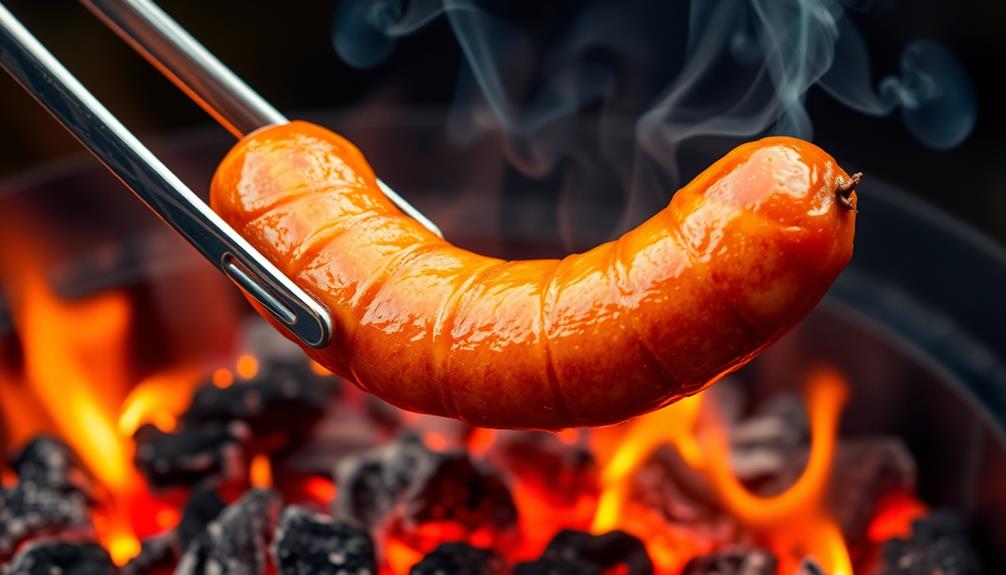
To achieve that signature smoky flavor, fire up a charcoal grill or smoker. Carefully place the sausages onto the grates, ensuring they're not touching. Close the lid and let the smoke work its magic. Maintain a consistent temperature between 200-225°F, adjusting the vents as needed. Resist the urge to peek – you'll lose precious smoke.
After 30-45 minutes, the sausages should develop a beautiful mahogany hue and take on a delightful smoky aroma. Use a meat thermometer to check for an internal temperature of 160°F. Once they're cooked through, transfer the sausages to a clean platter. Let them rest for 5-10 minutes before serving.
The key is patience – low and slow is the way to go for perfectly smoked sausages. With a little practice, you'll be churning out restaurant-quality Sai Oua every time.
Step 5. Serve Sai Oua Chilled
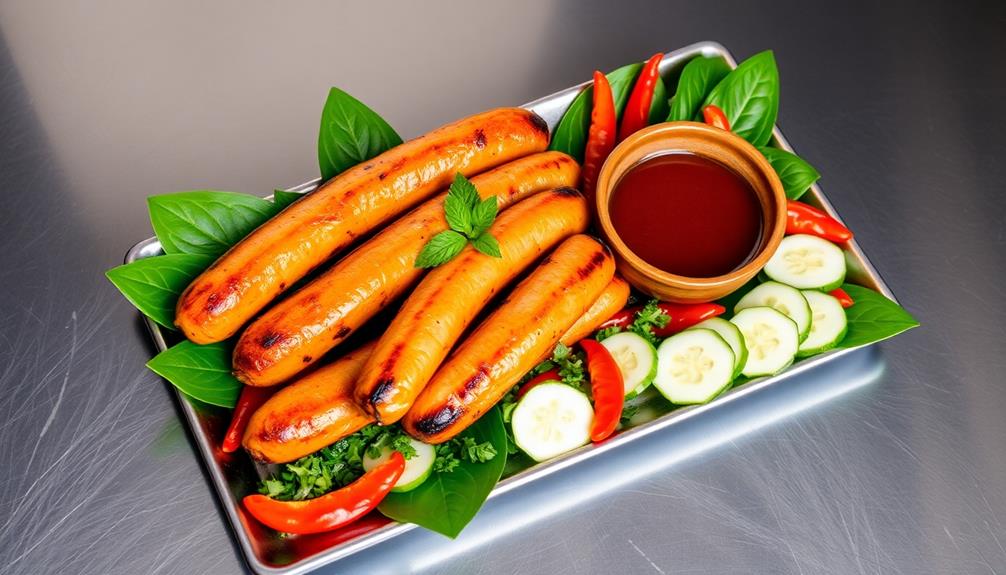
After the sausages have rested, it's time to chill them to perfection.
Grab a large bowl and fill it with ice water. Carefully lower the smoked sausages into the chilled water, making sure they're fully submerged. Let them sit for about 15 minutes, or until they've reached the desired temperature. This quick cooling process will help set the casing and lock in all those incredible flavors.
Once chilled, remove the sausages from the water and pat them dry with paper towels.
Slice them diagonally into bite-sized pieces, around 1-inch thick. Arrange the slices on a serving platter or board. You can garnish them with fresh herbs, like mint or cilantro, for a vibrant pop of color and flavor.
Serve the chilled sai oua immediately, allowing your guests to enjoy the perfectly cooked texture and smoky-savory goodness. The contrasting temperatures and textures make for a wonderfully refreshing and satisfying Northern Thai treat.
Final Thoughts
As you reflect on the Sai Oua, consider the significance of its role in Thai cuisine. This traditional Northern Thai sausage is more than just a tasty snack – it's a link to the region's rich culinary heritage.
The intricate process of making Sai Oua, from selecting the perfect ingredients to the careful casing and drying, demonstrates the dedication and pride of its producers.
Beyond its delicious flavor, Sai Oua also holds cultural importance. It's often served at important events and celebrations, cementing its place as a beloved part of Thai identity.
Whether you enjoy it chilled or at room temperature, this sausage is a testament to the ingenuity and resourcefulness of Northern Thai cooks.
As you savor the last bites, take a moment to appreciate the history and tradition that Sai Oua represents. It's a true taste of Thailand that deserves to be celebrated and preserved for generations to come.
Frequently Asked Questions
How Long Can Sai Oua Be Stored?
Properly stored, the sausage can last up to a week in the refrigerator or several months in the freezer. However, pay close attention to any signs of spoilage before consuming it to ensure food safety.
What Are the Traditional Serving Methods?
Traditionally, this savory dish is served in a variety of ways. You can enjoy it grilled, pan-fried, or sliced and added to soups or stir-fries. It's often accompanied by sticky rice and spicy dips for a complete Thai dining experience.
Can Sai Oua Be Frozen for Later Use?
Sure, you can freeze sausages for later use. Just make sure to wrap them tightly in plastic or foil to prevent freezer burn. This will help preserve their flavor and texture until you're ready to enjoy them.
What Are the Common Variations of Sai Oua?
Common variations of this type of sausage include different regional recipes, spice mixes, and protein fillings. Some may use pork, others beef or a combination. The flavors can range from mild to spicy depending on the herbs and seasonings used.
Are There Any Health Benefits Associated With Sai Oua?
There may be some potential health benefits associated with this type of sausage. It's made from natural ingredients and can be a source of protein. However, it's also high in fat and sodium, so it should be consumed in moderation as part of a balanced diet.
